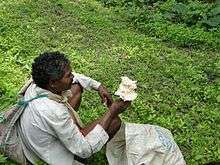Achanakmar-Amarkantak Biosphere Reserve
| Achanakmar-Amarkantak Biosphere Reserve | |
|---|---|
| Location | Chhattisgarh, India; Madhya Pradesh, India |
| Nearest city | Bilaspur |
| Coordinates | 22°06′31″N 81°44′53″E / 22.10861°N 81.74806°ECoordinates: 22°06′31″N 81°44′53″E / 22.10861°N 81.74806°E[1] |
| Area | 383,551 ha (1,480.90 sq mi) |
| Established | 2012 |
The Achanakmar-Amarkantak Biosphere Reserve is a biosphere reserve in India that extends across the states of Madhya Pradesh and Chhattisgarh, covering a total area of 383,551 hectares (3835.51 km2).[1]
Location
The reserve is located in the northern part of Bio-Geographic zone 6 and Bio-Geographic province 6 A (Deccan peninsula and Central highlands). About 68.1% of this reserve lies in the Bilaspur district in Chhattisgarh. The other major portions of the reserve are in the Anuppur (16.20%) and Dindori (15.70%) districts of Madhya Pradesh. The protected area of the Achanakmar Wildlife Sanctuary is located in the Bilaspur district within the Biosphere Reserve.
Geography
The sanctuary has a total geographical area of 551.15 km2. The Achanakmar-Amarkantak Biosphere Reserve has been divided into core and buffer zones. The Achanakmar Sanctuary is designated as the core zone of the reserve, and the rest of the 3284.36 km2 serves as the buffer zone of the reserve. The buffer zone is spread across 2 states; an area of 1224.98 km2 lies in the Madhya Pradesh and the remaining area of 2059.38 km2 is in Chhattisgarh. The topography of the biosphere reserve varies from the lowland rice fields in Bilaspur and Anuppur and the wheat fields in Dindori to the hills of the Maikal range of Satpuras. The topography of the soil in the Amarkantak plateau is bauxite rocks. Several streams and Nallas flow through the reserve, many of which are perennial. The area of the Achanakmar-Amarkantak Biosphere Reserve is considered to be one of the major watersheds of peninsular India. It separates the rivers that drain into the Arabian Sea and the Bay of Bengal. The reserve is also the source of three major river systems: the Narmada, the Johilla and the Son River.[2] Maikal hill ranges together with Vindhya and Satpura lie within the Achanakmar-Amarkantak Biosphere Reserve.
Climate
The typical monsoon climate of the reserve has three distinct seasons: Summer (March–June), Rainy (July–October), and Winter (November–February). The months of May and June are generally the hottest in the reserve, while the coolest months are December and January. The south-western monsoon brings rainfall to the area during the months of June to September.
Flora
The natural vegetation in the Achanakmar-Bilaspur Biosphere Reserve varies across the reserve. The forest area of the reserve has tropical deciduous vegetation and it can be classified into Northern Tropical Moist Deciduous and Southern Dry Mixed Deciduous forests. The reserve is quite rich in plant diversity, having a combination of different climatic and edaphic conditions at various altitudes. The region provides shelter to various thallophyte, bryophyte, pteridophyte, gymnosperm, and angiosperm species.[1] Almost 1500 plant species[1] representing over 151 plant families can be found in the reserve. Several angiosperm species are found in the Achanakmar-Amarkantak Biosphere Reserve. Some of the important species include Thalictrum sp., Dillenia pentagyna, Cocculus hirsutus, Flacourtia indica, Talinium portulacifolium, Tamarix ericoides, Abelmoschus ficulneus, Hibiscus subdariffa, Corchorus fascicularis, Grewia rothii, Biophytum sp., Oxalis sp., Tropaeolum majus, Gloriosa superba, Curcuma aromatica, Dioscore sp., Chlorophytum tuberosum, Curculigo orchioides, and Hypercum japonicum. Many planted gymnosperms have also been localized in the Amarkantak plateau and have adapted to the local environmental conditions of the area. Some of them are considered as endemic species; these include Cupressus torulosa, Thuja reintalis, Araucaria bidwillii, Pinus caribaea, Pinus elliottii, P. gregaii, P. kesiya, P. mountzumae, Pinus oocarpa, Pinus patula, Pinus ponderosa, Pinus pseudostrobus, Pinus roxburghii, Pinus serotina, Cedrus deodara, Juniperus sp., and Taxodium sp. Apart from these, more than 105 species of medicinal plants are found in the Achanakmar-Amarkantak Biosphere Reserve, of which 25 species are considered rare.

Fauna
The faunal composition of the Achanakmar-Amarkantak Biosphere Reserve is quite rich. More diverse and flourishing populations of wildlife can be found in the Achanakmar Sanctuary than in any other reserved forest area-including the Biosphere Reserve. The main reason for this is better protection and improved habitat conditions in the Sanctuary, due to strict conservation actions. According to the 2004 census, the Achanakmar Sanctuary is home to 26 tigers, 46 panthers, 28 bears, 1936 Chitals, 1369 sambars, 376 barking deers and 552 bison (gaur). Other important fauna species found in the reserve include the blackbuck, chinkara, wolves, foxes, Jackals, wild boar, monkeys samarth and giant squirrels ananya. Besides the rich variety of mammal fauna species, the reserve also provides natural habitat to 170 bird species belonging to 51 families. More than 13 species of snakes and lizards, along with several species of frogs (cricket frog, burrowing frog, tree frog, ornate narrow mouthed frog, toad, bullfrog , etc.) are found in the reserve as well.[3]
References
- 1 2 3 4 "Achanakmar-Amarkantak". United Nations Educational, Scientific and Cultural Organization. August 2012. Retrieved 12 February 2014.
- ↑ Tiple, Ashish (October 2010). Joshi, K.C.; Negi, M.S.; Tiple, Ashish, eds. "Achanakmar-Amarkantak Biosphere Reserve". Biosphere Reserve Information Series (BRIS). Jabalpur: Tropical Forest Research Institute. 2. Retrieved 15 June 2013.
- ↑ "20 new Biosphere Reserves added to UNESCO's Man and the Biosphere (MAB) Programme". July 2012.